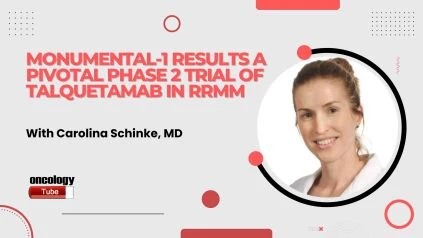“Correction: The mPFS is not 34 months but 34%.”
Carolina Schinke, MD from the UASM Health provided insights into the MonumenTAL-1 study, focusing on the bispecific antibody talquetamab as a potential treatment option for relapsed/refractory multiple myeloma.
Talquetamab has two domains—a GPRC5D-targeting domain for myeloma cells and a CD3 receptor for T-cells, connecting the two and enabling T-cell recognition and attack against myeloma cells.
The inclusion criteria for the study required patients with pre-treated relapsed multiple myeloma who had at least three prior lines of treatment, including exposure to an IMIT protosome inhibitor and CD38 antibody.
The study consisted of three cohorts, with the first two cohorts being treatment-naive to T-cell redirecting therapy, while cohort C included patients with prior T-cell redirecting treatment.
The patient population in the study mainly comprised patients with prior CAR T-cell treatment or bispecific antibody treatment targeting BCMA, as opposed to talquetamab specifically.
The overall response rates varied across the cohorts, with cohort A and B (treatment-naive) showing response rates of over 70%, while cohort C (prior T-cell redirecting treatment) demonstrated a response rate of 65%.
Patients with baseline plasmacytomas or high-risk cytogenetics had lower response rates compared to the general group. Median progression-free survival (PFS) was better in cohort B (dosing every other week) compared to cohort A (weekly dosing), suggesting improved outcomes with less frequent scheduling.
The safety profile of talquetamab revealed manageable adverse events, with cytokine release syndrome (CRS) being the most common but mostly grade 1 or 2.
Immune effector cell-associated neurotoxicity syndrome (ICANS) was rare, and infections were seen in up to 50% of patients, with a higher rate in cohort C.
Comparison with other treatment options for relapsed/refractory multiple myeloma showed similar response rates across bispecific antibody treatments.
Talquetamab exhibited distinct adverse events such as skin and nail changes and dysgeusia, but had fewer infections compared to BCMA-targeting bispecifics.
The study’s implications suggested that talquetamab could be a viable treatment option, particularly after BCMA-targeted T-cell redirection therapy.
The sequencing of bispecific antibody treatments and increasing the washout period between treatments were highlighted for optimal outcomes.
Key takeaways from the MonumenTAL-1 study emphasized the rapidly changing treatment landscape for relapsed myeloma.
The introduction of talquetamab alongside Teclistamab indicated promising efficacy. Managing CRS, though less severe than with CAR T-cell therapy, will be crucial.
Gaining experience with these effective drugs is vital, especially in heavily pre-treated relapsed/refractory myeloma patients.

